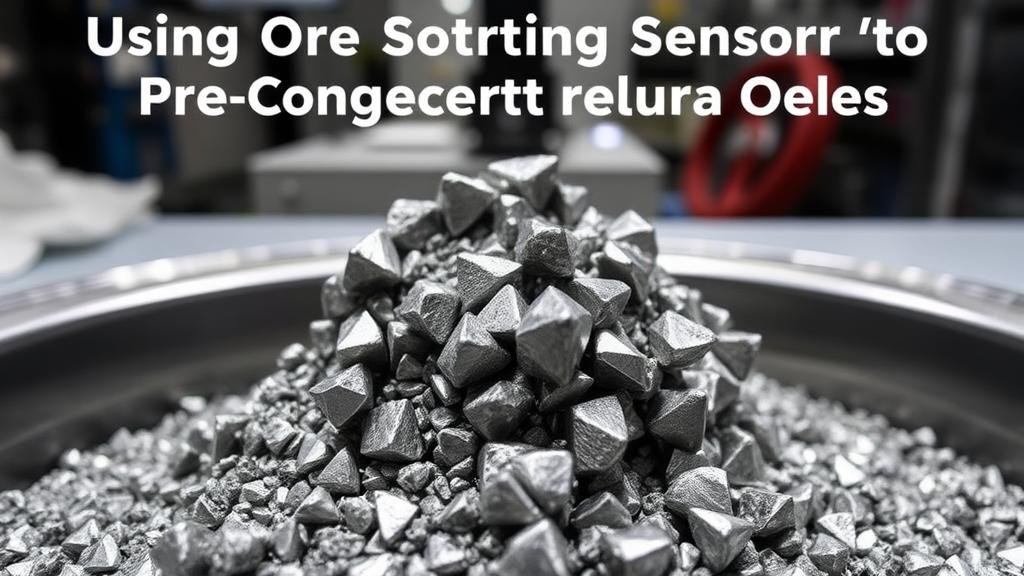Using Ore Sorting Sensors to Pre-Concentrate Low-Grade Silver Ores
Using Ore Sorting Sensors to Pre-Concentrate Low-Grade Silver Ores
The global demand for silver has been experiencing a significant increase due to its applications in electronics, photography, and renewable energy technologies. But, many silver deposits are classified as low-grade ores, making extraction economically challenging. One promising solution for this issue involves the use of ore sorting sensors for pre-concentration, enhancing the efficiency and profitability of silver mining operations.
Understanding Ore Sorting Technology
Ore sorting involves separating valuable minerals from waste material before the actual processing begins. This technology utilizes various sensors, such as X-ray fluorescence (XRF), near-infrared (NIR) spectroscopy, and laser-induced breakdown spectroscopy (LIBS), to identify and segregate ores based on their physical and chemical properties. By implementing ore sorting at the outset, mining operations can minimize the volume of material that needs processing.
Advantages of Using Ore Sorting Sensors
The incorporation of ore sorting sensors in silver mining has several distinct advantages:
- Enhanced Recovery Rates: By removing waste materials before processing, ore sorting increases the grade of the processed ore, leading to higher recovery rates of silver.
- Cost Efficiency: Reduced processing costs result from less energy and chemical usage, as only higher-grade materials are targeted for liberation during milling.
- Environmental Impact: Lower volumes of tailings generated during processing contribute to reduced land disturbance and waste management requirements, aligning with sustainable mining practices.
Real-World Applications: Case Studies
Several mining operations have successfully implemented ore sorting technologies to enhance silver recovery:
- SilverCrest Mines Inc.: At its Las Chispas project in Mexico, SilverCrest utilized ore sorting to separate high-grade silver ore from low-grade material. This led to a substantial increase in the average silver grade processed, resulting in improved profitability.
- First Majestic Silver Corp.: The company employed X-ray transmission (XRT) sorting on its silver properties, yielding an average grade increase of 200-300% for processed material, subsequently minimizing operational costs.
Challenges and Considerations
Despite the benefits, there are challenges in integrating ore sorting sensors into existing operations. Some of the common concerns include:
- Initial Investment: The upfront cost of acquiring and implementing sorting technology can be significant. Operators must evaluate the return on investment based on projected efficiency gains.
- Material Variability: Low-grade silver ores often exhibit variability, making it crucial to fine-tune sorting parameters to ensure optimal separation.
- Data Management: Efficient ore sorting generates extensive data that requires proper analysis to inform operational decisions. Mining companies must invest in skilled personnel or software solutions for effective data interpretation.
Actionable Takeaways
For mining companies considering the adoption of ore sorting sensors to enhance the pre-concentration of low-grade silver ores, the following actionable strategies should be prioritized:
- Conduct a Cost-Benefit Analysis: Assess the potential return on investment through increased recovery rates and lower processing costs.
- Choose the Right Technology: Evaluate the available sorting technologies based on the specific characteristics of the ore body being mined.
- Invest in Training: Ensure that staff are well-trained in operating sorting equipment and analyzing the data generated to maximize benefits.
To wrap up, ore sorting sensors present a transformative opportunity for the mining industry. By pre-concentrating low-grade silver ores, mining operations can not only improve their economic viability but also minimize their ecological footprint. As technology continues to evolve, ongoing investment in ore sorting will likely define the future landscape of silver mining.



